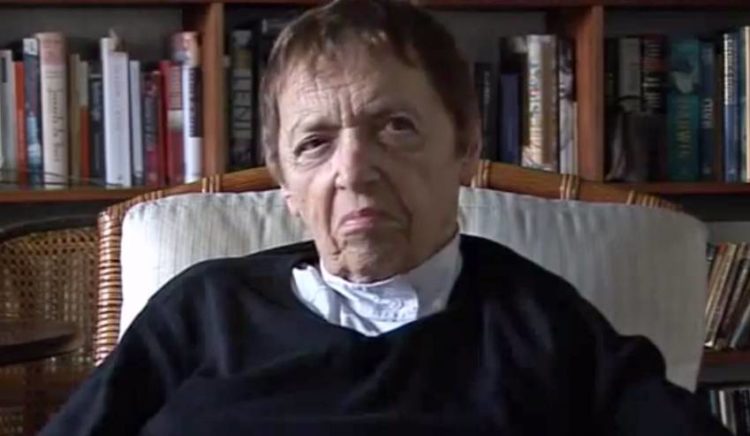Gitta Sereny’s “Holocaust” Worries Were Justified

She knew that the revisionists’ arguments were powerful; they could never be refuted — only suppressed. She also knew that Jewish holo-hucksters were lying like crazy.
by John Nobull
Foremost among the opinion-forming journals of twentieth-century Britain was the New Statesman. During the 1930s it worked in tandem with Victor Gollancz’s infamous Left Book Club in creating a psychosis of hatred for Germany. Adulation of Stalin was its forte, though later it obediently followed the new liberal-Jewish line, abjured Stalin and reviled the Russians.
In February 1979 they published a long article by the Hungarian Jewess Gitta Sereny, which expressed great concern about the goyim who were discovering truths about World War 2 that Jews didn’t want to be discovered. It is called “The Men Who Whitewash Hitler” and, just in case intellectual readers should miss the point, is embellished with a tasteful picture of a chimpanzee wearing a National Front armband, who is whitewashing a large swastika. She is very concerned at the success of writers like Richard Verrall and Arthur Butz in undermining the Holocaust myth. (Indeed, a contemporary letter from Verrall to the New Statesman adorns the centre of the article. The editor headed it, “A Nazi View of History,” when it was originally published. “We may despise them,” Ms. Sereny says of the revisionists, “but only at our peril do we mock and underrate them… They have succeeded to some extent in exploiting a terrible and astonishing fact, which is that after 35 years and billions of words, confusion still abounds on the subject of Hitler’s genocide.” The TV series Holocaust, for instance, is admitted to contain “factual errors.” Martin Broszat, Director of the Institute for Contemporary History in Munich, has made the embarrassing admission that there was no mass gassing in the camps on German soil. (Now he tells us, after so many “testimonies” and “proofs” of the opposite.) He tries to get round the “reconstructed” gas-chamber at Dachau by saying that it was “never used.” (Why not? Dachau was one of the earliest camps.) He explains that the (small) gas-chambers at other camps were used for “small groups of prisoners.” “Mauthausen, Natzweiler had one, Sachsenhausen too, I think,” says Broszat. Why doesn’t he know? Sachsenhausen was taken intact.
Ms. Sereny then goes on to ask a pertinent question: “How is it that the myth of gassing in the camps in Germany has been so universally accepted?” Could it be it has something to do with Jewish control over the media? No, “The explanation is both simple and infinitely complex.” Ignoring the red herrings which she drags across the trail, we discover that Auschwitz and Majdanek were “the only two where the Nazis combined enormous labour installations and nearby facilities for extermination. Auschwitz, because so many people survived it, has added most to our knowledge…”! (Italics hers, exclamation mark mine). Too many evil people have been reading Butz’s book, for at last we have a mention of the great Buna rubber factory, to serve which Auschwitz was built. The rule of parsimony requires us to assume the workers were needed for the factory and that therefore the place was not erected for mass extermination. But Ms. Sereny claims that there were big gassing facilities at nearby Birkenau. (She makes no mention of Thies Christophersen, who frequently visited both camps during the relevant period and saw no such facilities.) She tells us that only Jews were gassed, 700,000 of them, while 500,000, including 146,000 Jews are said to have died at Auschwitz “from exhaustion and disease.” Richard Verrall, “busy with his vile numbers game,” certainly seems to have been successful in reducing the numbers claimed for Auschwitz, which is now said to be “a complex, transitional example.” So what about the rest of the Six Million? Well, “Polish official estimates” claim two million Jews and 52,000 gipsies were exterminated at Chelmo, Belzec, Sobibor and Treblinka. None of these are exactly household names, except perhaps the last, and the suspcion must linger that, having been disproved in the German camps, and then (to a large extent) at Auschwitz, the Holocaust mythologists are falling back on a third position — easier to defend because so few victims allegedly survived. Ms. Sereny quotes documents indicating that in October 1943 the buildings at these four camps were pulled down and trees were planted in the earth “which had become so rich.” “Thirty-five years later they have grown tall.” (The arboreal detail is meant to explain the disappearance of thousands of tons of human ash which must have resulted from the cremation of over two million bodies. No such mountains of ash are in evidence anywhere.)
But mistakes have been made even regarding these last four “extermination camps.” For example, Martin Gilbert, the biographer of Churchill “perpetuates errors” about Treblinka “which — because they are so easily disproved — provide revisionists’ opportunities.” He gets the name of the camp commandant wrong and his heartrending references to the “cries of the victims and the weeping of the children” as being heard in the nearby villages cannot be true, as there were no villages for many miles. Nor were “the most famous musicians in the world” brought from the Warsaw ghetto to play when the transports arrived. She says, however, they were brought in to play to the workers at Auschwitz. (Funny people, these Germans, taking such trouble to entertain their victims.) Next, she grudgingly admits that David Irving’s book Hitler’s War is “partly true” and “has some interesting historical material,” though she deplores his claim that Hitler had nothing to do with any extermination program. She then goes on to condemn a whole row of philo-Semitic works which contain “exaggerations,” “false emphases” or “cheap humour.” Among these are François Steiner’s Treblinka and Martin Gray’s For Those I Loved. “When I myself told Gray that he has manifestly never been to, nor escaped from Treblinka, he finally asked despairingly: “But what does it matter? Wasn’t the only thing that Treblinka did happen, that it should be written about and that some Jews should be shown to be heroic?” She continues, “Every falsification, every error, every slick re-write job is an advantage to the neo-Nazis.” In other words, the exposure of lies aids those whom she hates and fears. Sereny does sound a bit hysterical when she refers to Britain as “now sadly enough a kind of neo-Nazi centre,” though perhaps someday that may be true. Could it be that a liking for the truth transforms anyone into a “neo-Nazi”?
* * *
Now I’ll tell you a story. Once upon a time, in the pretty town of Klosterneuburg, north of Vienna, there lived a gentleman of the old school. He was an ex-officer of the Imperial Army, and thoroughly disapproved of those crude fellows the Nazis, many of whom were recruited among the unemployed. When the Anschluss came, he did not make an accomodation with the new regime, as so many of his brother officers did, but held himself aloof, and was not molested. In due course, the war went sour, and he became the local representative of the Austrian Resistance Movement, an organization with remarkably few members until 1945, when it was joined by Simon Wiesenthal, among others. In due course, the German Army collapsed, and the Red army rolled over the remaining pockets of resistance. In his capacity as leader of the local Resistance (with a capital “R”) our hero greeted the Communists with flowers and welcomed them to Klosterneuburg. The Soviets responded by gang-raping all the women in the town, including the wife and daughter of the ex-officer. They were so badly treated that he shot them, and then shot himself.
I would not venture to point a moral to this little tragedy, but I can’t help wondering what his last thoughts were. Did he reflect that you can’t make an omelette without breaking a few eggs, or did he perhaps have some second thoughts about his former attitudes?
* * *
Source: based on an article in Instauration magazine, February 1980






Marianne Williamson & The Slaughter of Men, Women & Children in Gaza Now that’s a book worth writing! How about it, Marianne? Oh! And write a book about your Talmudic Jewish faith! THE TALMUD IS THE HEART’S BLOOD OF THE JEWISH RELIGION “The Talmud is to this day the circulating heart’s blood of the Jewish religion. Whatever laws, customs or ceremonies we observe ~ whether we are Orthodox, Conservative, Reform or merely spasmodic sentimentalists ~ we follow the Talmud. It is our common law.” ~ Herman Wouk We will legally define the Talmud as the basis of the Israeli legal system. ~ Benjamin Netanyahu The rule of the Talmudic Jew in modern times is nearly one of an absolute monarch of a country. The Jews, through their complete domination of… Read more »